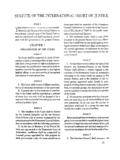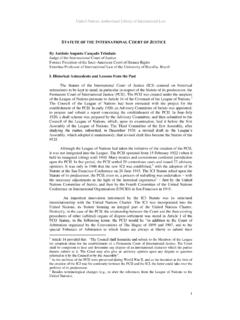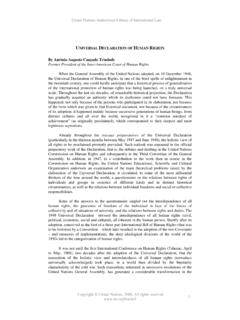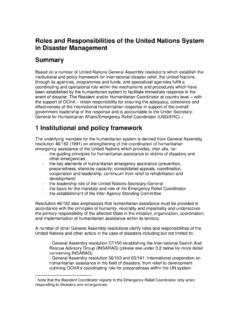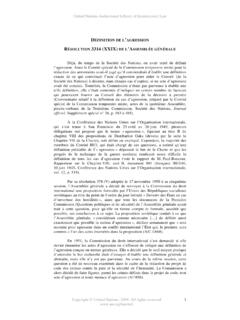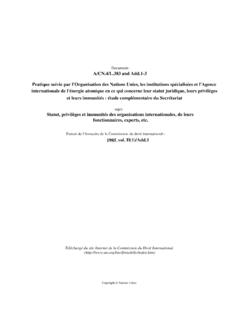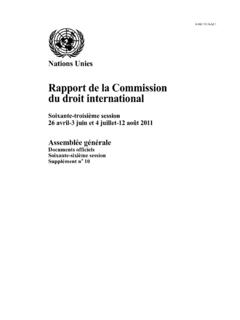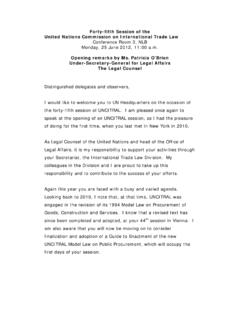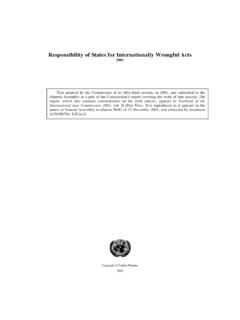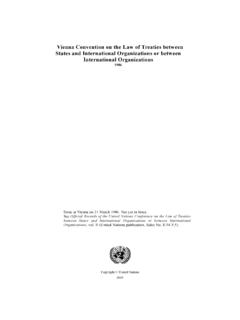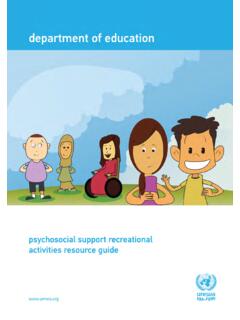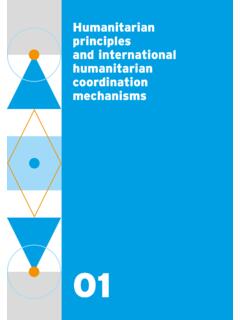Transcription of Roles and Responsibilities of the United Nations System in ...
1 Roles and Responsibilities of the United Nations System in disaster Management Summary Based on a number of United Nations General Assembly resolutions which establish the institutional and policy framework for international disaster relief, the United Nations , through its agencies, programmes and funds, and specialized agencies fulfill a coordinating and operational role within the mechanisms and procedures which have been established by the humanitarian System to facilitate immediate response in the event of disaster . The Resident and/or Humanitarian Coordinator at country level with the support of OCHA retain responsibility for ensuring the adequacy, coherence and effectiveness of the international humanitarian response in support of the overall government leadership of the response and is accountable to the Under Secretary-General for Humanitarian Affairs/Emergency Relief Coordinator (USG/ERC).
2 1 1 Institutional and policy framework The underlying mandate for the humanitarian System is derived from General Assembly resolution 46/182 (1991) on strengthening of the coordination of humanitarian emergency assistance of the United Nations which provides, inter alia, for: - the guiding principles for humanitarian assistance to victims of disasters and other emergencies - the key elements of humanitarian emergency assistance (prevention, preparedness, stand-by capacity; consolidated appeals, coordination, cooperation and leadership, continuum from relief to rehabilitation and development) - the leadership role of the United Nations Secretary-General - the basis for the mandate and role of the Emergency Relief Coordinator - the establishment of the Inter-Agency Standing Committee Resolution 46/182 also emphasizes that humanitarian assistance must be provided in accordance with the principles of humanity, neutrality and impartiality and underscores the primary responsibility of the affected State in the initiation, organization, coordination, and implementation of humanitarian assistance within its territory.
3 A number of other General Assembly resolutions clarify Roles and Responsibilities of the United Nations and other actors in the case of disasters including but not limited to: - General Assembly resolution 57/150 establishing the International Search And Rescue Advisory Group (INSARAG) (please see under below for more detail concerning INSARAG) - General Assembly resolution 56/103 and 63/141- International cooperation on humanitarian assistance in the field of disasters, from relief to development outlining OCHA s coordinating role for preparedness within the UN System 1 Note that the Resident Coordinator reports to the Emergency Relief Coordinator only when responding to disasters and emergencies. - General Assembly resolutions 54/219, 56/195, 59/233 and 63/216 covering the International System for disaster Risk Reduction International response to disasters is also supported by the IASC Operational Guidelines on Human Rights and Natural Disasters and by the Guidelines for the Domestic Facilitation and Regulation of International disaster Relief and Initial Recovery Assistance (the IDRL Guidelines ) which provide recommendations on domestic regulation of international assistance in disasters.
4 The IDRL Guidelines are a technical tool of reference to enhance legal preparedness through strengthening national institutional, policy or legal frameworks. They are anchored in existing norms and standards including UN General Assembly Resolution 46/182; the Oslo Guidelines on the Use of Military and Civil Defence Assets in disaster Relief, the Hyogo Framework for Action 2005-2015, the Sphere Minimum Standards in disaster Response, Code of Conduct for the Red cross /Red crescent and NGOs in disaster Relief and the Good Humanitarian Donorship Principles. 2 Coordination The international humanitarian community organizes itself in support of the government leadership of response by coordinating through sectoral working groups.
5 This concept is embodied in the cluster approach , an IASC-agreed approach which brings all relevant actors together in order to strengthen coordination among humanitarian actors and between the humanitarian actors and the government and address the gaps in the emergency response. The cluster approach clarifies the division of labor among organizations, and better defines their Roles and Responsibilities within the different sectors of the response. The Cluster approach operates at two levels. At the global level, the aim is to strengthen System -wide preparedness and technical capacity to respond to humanitarian emergencies by designating global Cluster Leads and ensuring that there is predictable leadership and accountability in all the main sectors or areas of activity.
6 At the country level, the aim is to ensure a more coherent and effective response by mobilizing groups of agencies, organizations and NGOs to respond in a strategic manner across all key sectors or areas of activity, each sector having a clearly designated lead, as agreed by the Resident and/or Humanitarian Coordinator after consultation with the Humanitarian Country Team and all relevant actors. The designated Global Cluster Leads, as agreed by the IASC are as follows: Agriculture (FAO) Camp Coordination/Management (UNHCR and IOM) Early Recovery (UNDP) Education (UNICEF & Save the Children) Emergency shelter (UNHCR and IFRC - as convenor) Emergency Telecommunications (OCHA, UNICEF & WFP) Health (WHO) Logistics (WFP) Nutrition (UNICEF) Protection (UNHCR)2 Water, Sanitation and Hygiene (UNICEF) All sector/clusters have the responsibility to include the following cross -cutting issues in their work: HIV/AIDS, gender, environment, age and human rights protection and early recovery while often separate sectors should also be mainstreamed across the work of all sector/clusters.
7 Sectors/clusters are established at country level as required in response to the specific needs of each emergency response, and considering the presence and capacity of the humanitarian actors. A key responsibility of cluster/sector leads at the country level is to ensure that humanitarian actors build on local capacities and that they develop and maintain appropriate links with Government and local authorities, state institutions, local civil society and other stakeholders. The affected State has the primary role in the initiation, organization, coordination, and implementation of humanitarian assistance. 3 Operational humanitarian response For planning purposes, disaster management can be divided into a series of phases on a time continuum which normally includes disaster response, recovery, mitigation and preparedness.
8 However, field experience has shown that two or more of these disaster management phases may take place concurrently. The UN System provides operational inputs and services and tools to support Governments and the humanitarian community to respond effectively and in a coordinated manner to disasters in order to minimize the impact of such events on the most vulnerable. disaster Preparedness The United Nations System supports and engages in activities in advance of forecast disasters by decreasing the vulnerability of populations to the effects of disaster (reducing disaster risk) and by increasing the capacity of individuals, communities and authorities to deal with the adverse effects of a disaster (increasing preparedness for effective response).
9 The ISDR System Hyogo Framework for Action 2005-2015 : Building the resilience of Nations & communities to disasters provides the policy and institutional basis for risk reduction and disaster preparedness. Priority 5 of the HFA seeks to strengthen disaster preparedness for effective response at all levels noting that impacts and losses can be substantially reduced if authorities, individuals and communities in hazard-prone areas are well prepared .. and equipped with the knowledge and capacities for effective disaster management. Within this framework, preparedness activities would typically include contingency planning, risk analysis, capacity and vulnerability assessment, mapping of hazards & 2 IASC Guidance Note for Using the Cluster approach to Strengthen Humanitarian Response, November 2006: UNHCR is the lead of the global Protection cluster.
10 However, at the country level in disaster situations or in complex emergencies without significant displacement, the three core protection-mandated agencies (UNHCR, UNICEF and OHCHR) will consult closely and, under the overall leadership of the HC/RC, agree which of the three will assume the role of Lead for protection. Within the Global Protection Cluster, a Core Group focuses on protection concerns in disaster situations. threats, the development of early warning systems, contingency stockpiling and logistics facilitations arrangements with host governments in disaster -prone countries (see also IDRL). The development of most of these activities is supported by the work of the IASC Sub Working Group on Preparedness and Contingency Planning.
